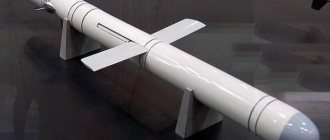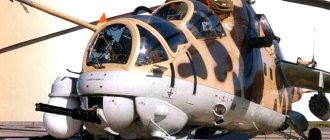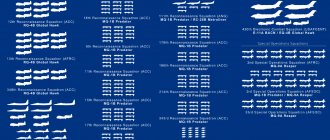Author: Rastrelli V.V.
09 November 2022 00:59
Tags: PAK DA Russia war strategic bomber
6494
4
The development of the new generation Russian strategic bomber-missile carrier PAK DA (advanced long-range aviation complex) is under the personal control of the head of state. This was stated by the United Aircraft Corporation (UAC).
0
Experts note that when developing the new aircraft, engineers relied on stealth, sacrificing supersonic speed. The new missile carrier is designed to significantly strengthen the air component of the Strategic Nuclear Forces of the Russian Federation. The development of the new generation strategic bomber-missile carrier PAK DA (advanced long-range aviation complex) is under the personal control of the head of state. The United Aircraft Corporation (UAC) spoke about this. The corporation also recalled other developments that will not only preserve, but also strengthen an integral part of the nuclear triad - the strategic bomber corps. Already, the potential of domestic long-range aviation is being strengthened thanks to the modernization of the Tu-160M and Tu-95MS missile carriers. These legendary aircraft will not soon exhaust their service life, but by then they will be replaced by the PAK DA, being constructed on the basis of the aircraft plant in Kazan.
Focus on stealth
0
Let us remember that the conceptual design of the future aircraft was agreed upon in 2013. The project of the Tupolev Design Bureau was recognized as the most promising. The designers proposed sacrificing supersonic characteristics for the sake of radar invisibility; it was decided to use stealth technologies in the PAK DA. The aircraft will be built according to the “flying wing” design. Of course, any army in the world would like to be armed with a bomber that combines supersonic speed with stealth, however, according to experts, at this stage of scientific development such a solution is impossible to implement. To move at supersonic, and even more so at hypersonic speeds, the aircraft must have streamlined aerodynamics. However, such streamlining will not allow the device to remain invisible to enemy radars, since it is the angular shape of the body that ensures invisibility. Another difficulty is associated with the engine air intake, which is closed from radar radiation on stealth aircraft. But this solution is not suitable for flights at supersonic speeds - aircraft need an open and wide air intake duct, since the oxygen consumption of the engine increases significantly. “Why the emphasis is on stealth is understandable - the laws of physics themselves do not imply long flights at supersonic speed,” explained the editor-in-chief of Arsenal of the Fatherland magazine, reserve colonel Viktor Murakhovsky, in an interview with RT. “Yes, our Tu-160, which is still in service, is a supersonic aircraft, but it can fly at such a speed not the entire distance, but only some separate sections, for example, if necessary, overcome the air defense line.”
×
At the same time, completely invisible aircraft do not exist; stealth aircraft are still visible on radar, but at much shorter distances than conventional aircraft, the expert added. Strategic bombers are subject to increased requirements for range and duration of autonomous flight; in this case, such a parameter as efficiency comes to the fore. The “air wing” design will help increase this parameter, the specialist is sure. Despite the complexity of the task, work on creating a missile carrier of the future is actively moving forward. By March last year, the Tupolev Design Bureau created a full-size mock-up of the PAK DA. In May 2022, the PAK DA digital model was completely ready. UAC Vice President for Innovation Sergei Korotkov told the media about this. Digitization of the aircraft will allow for maintenance of the PAK DA at all stages of its life cycle, UAC explained. In the summer, the corporation defended the preliminary technical design of the PAK DA, moving on to a new stage of work - development. It is assumed that the first prototype of the aircraft will be able to take off in 2025; the Kazan Production Association named after Gorbunov (a branch of PJSC Tupolev) is engaged in the construction of the device. It is known that the PAK DA will carry a wide range of weapons on board, including hypersonic missiles. The flight range will be about 12 thousand km, the speed will be about 1000 km/h, the take-off weight will not exceed 110 tons. At the beginning of October 2022, the estimated characteristics of the engine of the future bomber became known. In particular, journalists managed to find out that the engine will be protected from some damaging factors of a nuclear explosion, and the power plant will be able to operate at temperatures from -60 to +50 °C. Without repairs, the engine must operate for at least 600 hours, the full service life will be 8 thousand hours, or 12 years of operation with the possibility of extending this period to 21 years. The relevant requirements were specified in tenders posted on the government procurement website. It is also known that the body of the PAK DA will be made primarily of lightweight and durable composite materials, in particular, the option of using titanium is being considered - Russia is the leader in the extraction of this metal.
0
The PAK DA navigation system will not be tied to satellite signals, but will be guided by astronomical data. This will make the vehicle less vulnerable to electronic warfare. In addition, as former commander-in-chief of the Russian Aerospace Forces Viktor Bondarev previously told reporters, new missiles are being developed for the PAK DA, the destruction radius of which will reach 7 thousand km. The missiles are planned to be equipped with computer systems capable of analyzing the air and radar situation. There is no rush to develop such a machine as a strategic bomber, experts say. “Creating a new strategic bomber is a long process,” Murakhovsky explained. — Firstly, we are talking about very complex advanced technologies. Secondly, both we and the Americans now have strategic bombers of the previous generation in service, in the USA this is the B-52 aircraft.” Aircraft developed in the last century can still be successfully used, not to mention modernized versions such as the Tu-160M2. Making an aircraft superior to these models is an extremely difficult task, experts say. “In any case, new aviation complexes will not soon replace their predecessors; there is no point in rushing events in this area,” says Murakhovsky.
LONG LONG AVIATION OF RUSSIA
PAK YES, factory designation: “product 80”, also known as “Messenger”, is being developed. A promising long-range aviation complex is a project of a new generation Russian strategic bomber-missile carrier. The project is not a modernization of existing machines, but represents a fundamentally new aircraft.
As you know, work on developing the product concept began 10 years ago, in 2009. It is assumed that the rollout of the first prototype will take place in two to three years, with the first flight in 2025–2026.
Some bombers from the Tu family can break through air defenses, others fly record distances. The “Russian stealth” PAK DA is designed to combine both of these “killer” characteristics. This fifth-generation missile carrier should enter service in 10 years: the adoption and start of operation of the missile carriers is planned for 2028–2029.
In the future, the PAK DA should replace the Tu-95 and Tu-160 long-range aviation aircraft currently in service with the Russian Aerospace Forces and partially take over the functions of the Tu-22M3.
The developers successfully defended the project of a promising long-range aviation complex (PAK DA). As Interfax reports, citing a source in the military-industrial complex, the Russian military has approved the appearance of the new aircraft and its technical characteristics. In addition, we signed all the necessary agreements under which construction of the first flight models of the strategic bomber will begin.
The aircraft used by Russian Long-Range Aviation are certainly gradually becoming obsolete. As new air defense systems emerge, the effectiveness of such aircraft is only decreasing. The new long-range bomber will eventually have to replace three types of combat aircraft at once: Tu-22M3, Tu-95MS and Tu-160. The PAK DA will not only serve as a strategic bomber, but also be used as a missile-carrying bomber, long-range interceptor, and even as a platform for launching spacecraft.
PAK YES
As you know, the development of a new bomber has been underway since 2013. According to the technical specifications of the Russian Ministry of Defense, this strategic bomber must not only carry as many weapons as possible, but also be invisible and use any airfields.
The PAK DA will be built using stealth technologies using the “flying wing” aerodynamic design – that is, without a tail unit. And it will fly at subsonic speeds.
Officially, all that is known so far is that it will be able to carry more weapons than the Tu-160. First of all, these will be long-range cruise missiles (2-4 thousand kilometers), which will be able to carry not only conventional, but also nuclear warheads. The developers are currently considering the Kh-102 missiles, which can hit ground and sea targets, as the main weapon. And also, the range of weapons of the new bomber will include hypersonic weapons.
Particular attention in the design of the aircraft is paid to the use of stealth technologies. The PAK DA will use several stealth technologies. This includes a radio-absorbing coating, structural elements, as well as the geometric shape of the airframe.
The aircraft's invisibility to radar should be ensured by Russian know-how - a special radar-absorbing coating. As well as the maximum possible use of composite materials.
To reduce the bomber's effective scattering area, it will only have internal weapons bays.
In July 2022, it was reported that the United Aircraft Corporation defended the preliminary technical design of the PAK DA, and also began development work to create a new bomber. At the preliminary design stage, the possible appearance of the equipment, the main functions it will perform, possible weapons and use scenarios are determined.
Meanwhile, in December last year, the Kazan Aviation Plant named after Gorbunov resumed production of Tu-160M strategic missile-carrying bombers. Now the company is assembling completely new aircraft; for their construction, parts from the Soviet stock are not used. Based on the results of testing these bombers, the military will decide to begin mass production of the vehicles. Serial production of Tu-160 bombers was suspended in Russia in 1994.
Project development
In August 2009, the Russian Ministry of Defense signed a contract to conduct R&D to create the PAK DA for a period of 3 years. The technical design of the new bomber will be fully completed by 2015. This must be a fundamentally new aircraft. It will be based on conceptually new solutions that will allow us to be competitive in this area at the turn of 2022.
Scientific research work should be considered as the creation of a certain scientific and technical basis on this topic. This is not only and not so much a military theme, but a study of issues of aerodynamics, strength, new materials and technologies. Igor Shevchuk, general designer
In August 2012, it was announced that the preliminary design of PAK DA had already been completed and approved. Development work on it begins. The aircraft project was approved in March 2013.
The development of the preliminary design was carried out by teams from TsAGI and Tupolev Design Bureau. When considering the presented concepts, preference was given to the development of the Tupolev. In April 2014, it became known that the Tupolev Design Bureau had completed the pre-design stage of the PAK DA.
According to experts, the new long-range missile carrier will be designed according to the “flying wing” design, like its American counterpart B-2 Spirit. Only this arrangement ensures low visibility of the aircraft for radars operating at long waves. The significant wingspan and design features will not allow the aircraft to overcome the speed of sound. At the same time, reduced visibility for radars will be ensured. PAK DA will certainly be equipped with the most modern electronic equipment. Including radar, navigation, communications and electronic warfare systems.
In June 2014, information appeared about the alleged developer of the propulsion system of the new missile carrier. The new engine should be created by the Samara engine building company, which won the competition for the corresponding work. The engine will be created using gas generator technologies from the NK-32 engine. Presumably, we are talking about the NK-65 engine project.
The designed aircraft has the internal design bureau designator “product 80”. The production of prototypes, as well as the deployment of serial production, is expected at Kazan Aviation, which is a production branch of Tupolev OJSC.
"MESSENGER" video
NGB
A similar project called Next Generation Bomber is currently being developed in the interests of the US Air Force. The military requirements for the vehicle were drawn up in 2011. According to media reports, the cost of the aircraft will be more than half a billion dollars. The new bomber will be subsonic, its flight range will exceed 9 thousand kilometers. The NGB's combat load will be 6.3 - 12.7 tons. The aircraft must be “optionally manned,” meaning it can carry out missions without a crew. In this case, the machine will be able to stay in the air for more than four days.
As is known, NGB is designed with extensive use of stealth technologies. According to experts, this should give the new bomber the ability to carry out air strikes in the daytime, even in the face of enemy air defense systems.
American "spirit"
0
The PAK DA will become a fifth-generation aircraft, characterized, not least, by the use of stealth technologies. The aircraft's stealth is directly related to its ability to reflect and scatter electromagnetic waves, which is achieved by applying a special radio-absorbing coating to the body and modifying the very shape of the aircraft. To date, the only example of the use of stealth technologies in long-range aviation is the American B-2A Spirit strategic bomber. The first demonstration flight of the aircraft took place in 1989; only 21 aircraft of this series entered service with the US Armed Forces. Also, this machine was the first to implement the “flying wing” design. However, the price of the B-2A Spirit broke all records: at the time of 1998, one copy of the bomber cost $1.16 billion. They started talking about the need to create a replacement for the B-2A in the United States in the early 2000s. Initially, the program was called “2018 Bomber”; it was planned that the new aircraft would be put into service by the end of the 2010s. The program was subsequently renamed Next-Generation Bomber (NGB), and Boeing and Lockheed Martin took part in it. However, in 2008 the project was closed, and instead the Pentagon announced a new program - the Long Range Strike Bomber (LRS-B). Its implementation was undertaken by the company developing the B-2A Spirit Northrop Grumman. In 2016, the development company presented a project for a promising aircraft LRS-B (B-21). According to the designers, the price of one aircraft will not exceed $564 million. It is assumed that the new bomber will repeat and develop the advantages of its predecessor, but will get rid of the shortcomings of the B-2. Today it is known that the aircraft will be subsonic and stealthy. Its main goal will be the destruction of enemy air defense systems in order to open the way for tactical aviation. It is planned that serial B-21s will be handed over to the troops at the end of the first half of the twenties. No later than 2025, these vehicles will have to reach the stage of initial operational readiness. It should be noted that the PRC is also working on creating strategic bombers of the future. The presentation of the stealth Xian H-20 missile carrier to the Xi'an Aviation Industry Corporation (XAC) is scheduled for the end of 2019, when the PRC will celebrate the 70th anniversary of the national air force. Development of the N-20 began in 2008 at the Shanghai Aviation Design Research Institute. Although the bomber's key characteristics are classified, experts suggest that the N-20's flight range will be up to 8 thousand km with a combat load of 10 tons. In terms of timing, China is still ahead of both Russia and the United States - in August of this year, a finished sample of the N-20 was demonstrated on China Central Television. The speed at which Beijing is building its own long-range bomber has already raised concerns in the United States. As noted in a recent Pentagon report submitted to the Senate, the PRC is seeking to expand the coverage area of its military operations. As a result, American naval bases in the Asia-Pacific region may find themselves within the reach of the Chinese Air Force - first of all, we are talking about the new stealth long-range bomber. The N-6 strategic bombers currently in service with the PLA can fly no more than 5 thousand km without refueling, carrying less than 10 tons of weapons on board. For comparison, the Russian Tu-160 has a combat load of 45 tons. Speaking about the Chinese N-21 project, experts prefer not to rush into assessments. According to Viktor Murakhovsky, it is too early to talk about what the Chinese strategic bomber will be like. “Television footage alone, of course, is not enough to judge the quality and efficiency of these machines,” the expert believes. Military expert Alexey Leonkov shares a similar point of view. In his opinion, China can really quickly build a large number of ships and aircraft - resources allow. “However, military equipment is assessed primarily from the point of view of tactical and technical characteristics. How effective Chinese developments are will become clear later,” the expert emphasized.











